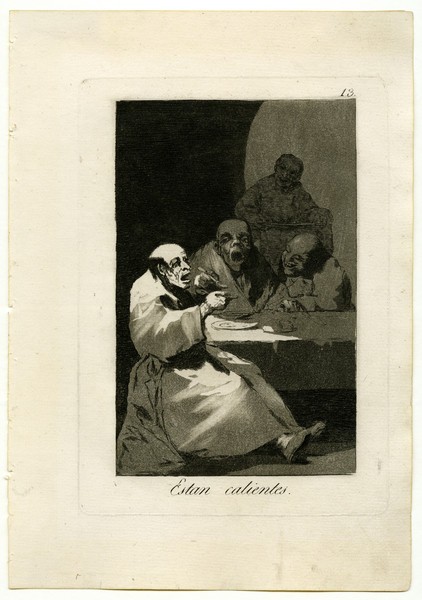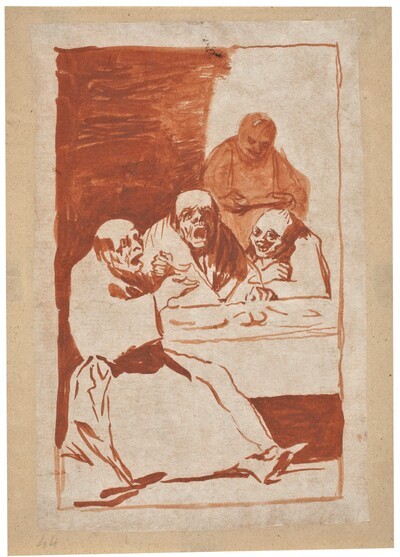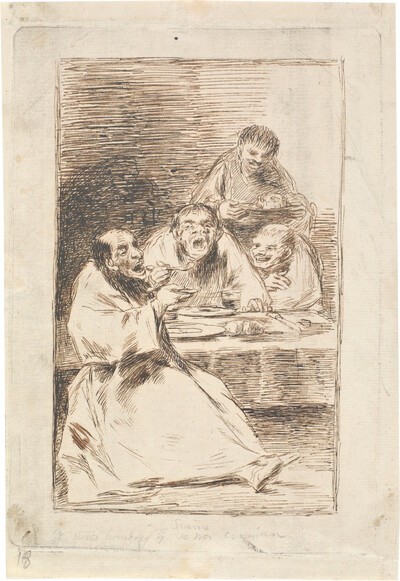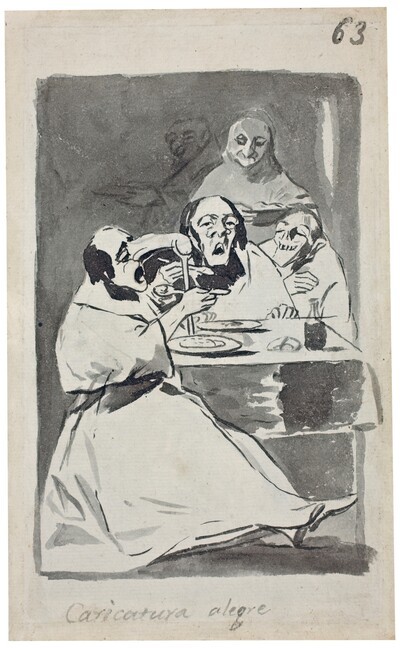- Cronología
- Ca. 1797 - 1799
- Dimensiones
- 219 x 153 mm
- Técnica y soporte
- Etching and burnished aquatint
- Reconocimiento de la autoría de Goya
- Undisputed work
- Ficha: realización/revisión
- 23 Nov 2010 / 29 May 2024
- Inventario
- 225
They are hot (at the bottom)
3. (in the upper right corner)
See Francisco de Goya y Lucientes, Painter.
Se conoce la existencia de cuatro pruebas de estado antes de que Goya trabajase con el bruñidor el aguatinta de las cuales dos tienen el título manuscrito. La primera de ellas se encuentra en la Bibliothèque Nationale de France en París y presenta una descuidada caligrafía, mientras que la del Metropolitan Museum of Art de Nueva York ha sido realizada con mayor esmero para que el grabador siguiese la letra.
Han de considerarse dibujos preparatorios para este grabado el que forma parte del Álbum de Madrid, así como el Sueño nº 25, Sueño de unos hombres q.e se nos comían y el dibujo titulado Están calientes, conservado en el Museo Nacional del Prado.
In a dark setting in which we can make out an arch in the background, we can see four figures dressed in tunics that indicate that they belong to a religious sphere. Three of them are seated at a table, two facing the front and the third in profile. In the background we can make out the fourth, who is holding a tray. The faces of all of them are caricatured, almost deformed, their mouths enormous and, in some cases, open. The light illuminates the figure seated in profile on the left, his face cadaverous and disturbing, the hand holding a spoon in his mouth and the plate on the table.
Ayala's manuscript explains this engraving by saying "the stupid friars binge, there at their hours, in the refectories, laughing, and they laugh at the world; what should they do but be horny! The manuscript in the Prado Museum notes that "they are in such a hurry to gulp that they swallow them boiling hot. Even in the use of pleasures, temperance and moderation are necessary". Finally, the manuscript in the National Library comments on this engraving that "the foolish friars binge well in their refectories, and laugh at the world; what are they to do afterwards if they are not horny".
There is no doubt that Goya makes a merciless criticism of the clergy who, at times, beyond their vows and their promise to lead an austere and simple life, give in to earthly pleasures. One could even extend the hunger of these friars to their sexual appetite, so that the title of the engraving acquires a double meaning. This hypothesis becomes more plausible if we look closely at the drawing in the Madrid Album or Album B, Joyful Charitature, in which one of the friars has an inordinately large, phallic-shaped nose; its size is such that he must hold it with a small crutch.
The plate is preserved in the National Chalcography (no. 184).
-
Goya. Gemälde Zeichnungen. Graphik. TapisserienKunsthalle BaselBasle1953from January 23th to April 12th 1953cat. 205
-
Goya dans les collections suissesFundación Pierre GianaddaMartigny1982consultant editor Pierre Gassier. From June 12th to August 29th 1982cat. 46
-
Goya. La década de Los CaprichosMadrid1992organized by Real Academia de Bellas Artes de San Fernando sponsored by Fundación Central Hispano, Madrid, consultant editor Nigel Glendinnig. From October 26th 1992 to January 10th 1993cat. 151
-
Francisco de GoyaMuseo d'Arte ModernaLugano1996exhibition celebrated from September 22nd to November 17th.cat. 13, p.40
-
Francisco Goya. Sein leben im spiegel der graphik. Fuendetodos 1746-1828 Bordeaux. 1746-1996Galerie KornfeldBern1996from November 21st 1996 to January 1997cat. 19
-
Goya artista de su tiempo y Goya artista únicoThe National Museum of Western ArtTokyo1999from December 1st to July 3th 1999cat. 127
-
Francisco Goya. Capricci, follie e disastri della guerraSan Donato Milanese2000Opere grafiche della Fondazione Antonio Mazzottacat. 13, p.21
-
Goya e la tradizione italianaFondazione Magnani RoccaMamiano di Traversetolo (Parma)2006consultant editors Fred Licht and Simona Tosini Pizzetti. From September 9th to December 3th 2006cat. 13, p.149
-
Goya. Opera graficaPinacoteca del Castello di San GiorgioLegnano2006exhibition celebrated from December 16th 2006 to April 1st 2007p.26
-
Goya e ItaliaMuseo de ZaragozaZaragoza2008organized by the Fundación Goya en Aragóna, consultant editor Joan Sureda Pons. From June 1st to September 15th 2008cat. 320
-
Goya luces y sombrasCaixaForumBarcelona2012consultant editors José Manuel Matilla and Manuela B. Marqués. From March 16th to June 24th 2012cat. 24-25
-
Goya et la modernitéPinacothèque de ParisParís2013from October 11st 2013 to March 16th 2014cat.5
-
Goya: Order and disorderMuseum of Fine ArtsBoston2014cat. 158
-
Hamburg2019cat. 78
-
Goya engravings and lithographs, vol. I y II.OxfordBruno Cassirer1964p.81, cat. 46
-
Vie et ouvre de Francisco de GoyaParísOffice du livre1970p.177, cat. 476
-
Goya, la década de los caprichos: dibujos y aguafuertesMadridReal Academia de Bellas Artes de San Fernando1992pp.248-253, cat. 148-152
-
Catálogo de las estampas de Goya en la Biblioteca NacionalMadridMinisterio de Educación y Cultura, Biblioteca Nacional1996p.80, cat. 101
-
El libro de los caprichos: dos siglos de interpretaciones (1799-1999). Catálogo de los dibujos, pruebas de estado, láminas de cobre y estampas de la primera ediciónMadridMuseo Nacional del Prado1999pp.110-115
-
Bellacos, lisonjeros y amigos de mesa defraudadores de la verdad. Caprichos 11, 12 y 13,Boletín de la Real Academia de Bellas Artes de San FernandoMadridReal Academia de Bellas Artes de San Fernando2001pp.45-65
-
ParísPinacoteca de París2013p. 63
-
Goya: Order & DisorderBostonMuseum of Fine Arts Boston Publications2014pp. 242-244
-
Goya. In the Norton Simon MuseumPasadenaNorton Simon Museum2016pp. 42-75
-
HamburgHirmer2019p. 290



